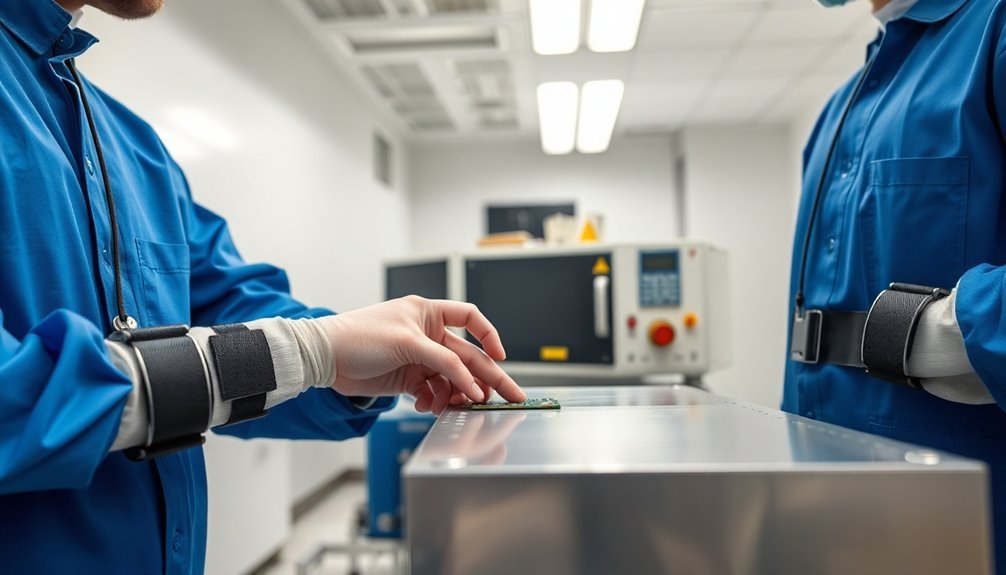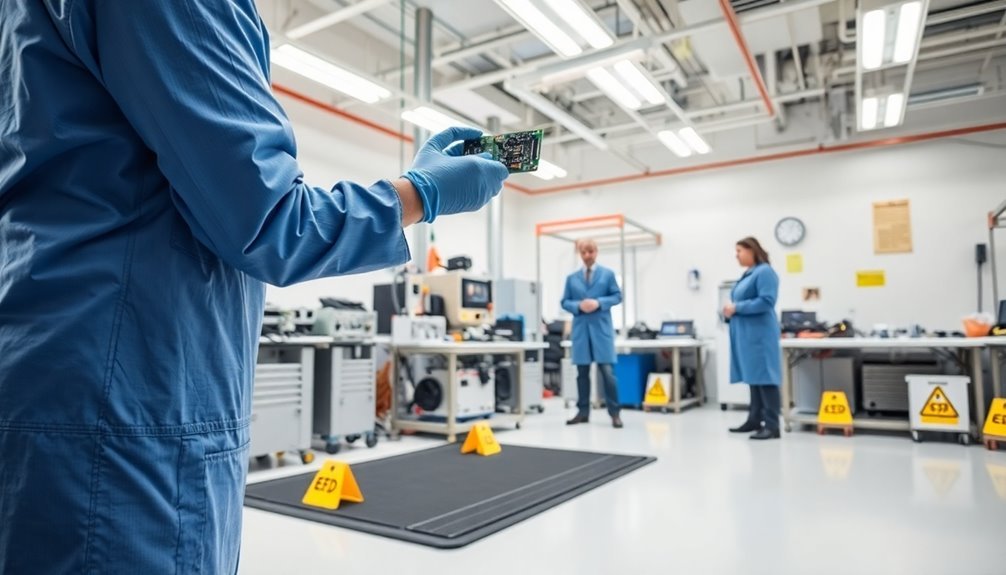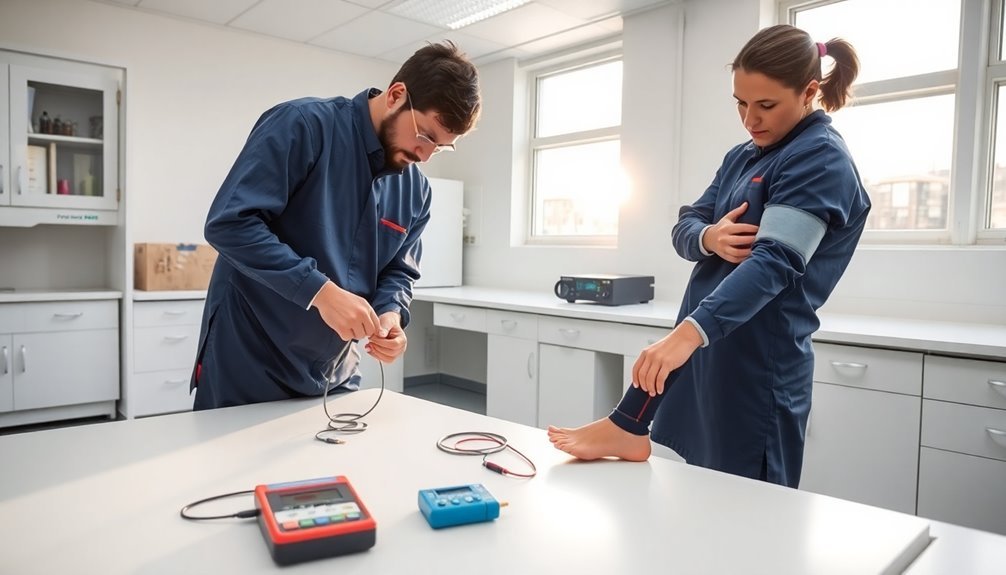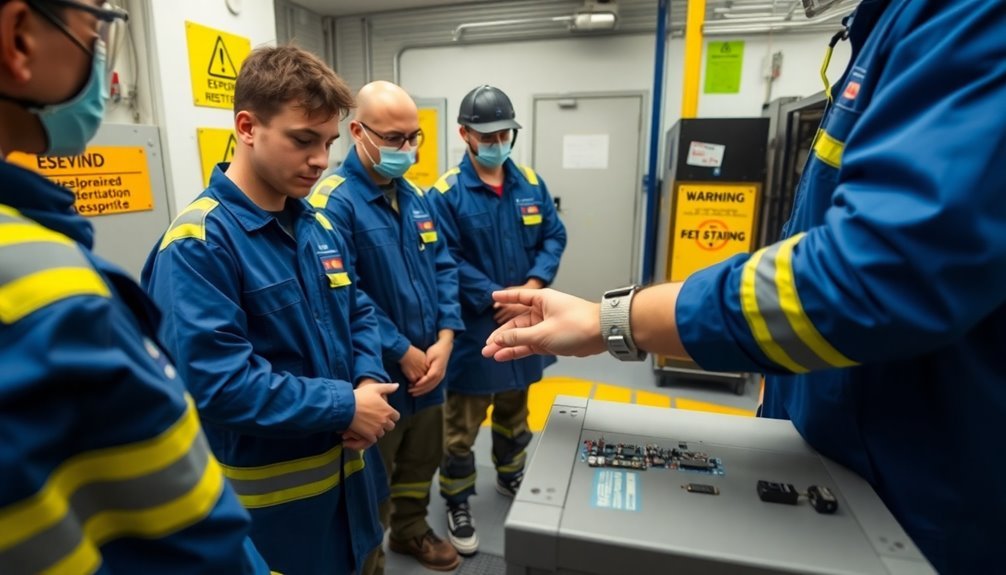Start by training your team on static electricity fundamentals, including how charges build up through everyday movements and material handling. You'll need to implement proper grounding techniques, ESD-safe workstations, and protective equipment like wrist straps and anti-static gloves. Make sure everyone understands their role in maintaining static control protocols and regularly tests all equipment. Establish clear emergency procedures and conduct routine safety drills focused on static-related scenarios. You'll also want to organize workspaces to minimize static risks and keep detailed monitoring logs. The deeper you explore static control safety measures, the better protected your team and equipment will be.
Understanding Static Electricity Basics

Static electricity occurs when there's an imbalance between negative and positive charges on a material's surface. This typically happens through the triboelectric effect, where electrons transfer from one material to another when they're rubbed together or separated.
One material gains electrons and becomes negatively charged, while the other loses electrons and becomes positively charged.
You'll notice static electricity is more prevalent in dry conditions because moisture in the air helps prevent charge buildup. When charges accumulate, they can cause materials to attract or repel each other, create sparks, or deliver unexpected shocks.
The good news is you can control static electricity through proper grounding and using anti-static materials. Effective grounding systems require connecting all components to a common point ground.
Understanding these basics helps you recognize why static control matters, especially when handling sensitive electronic components. Without proper precautions, static discharge can damage equipment and create safety hazards for your team.
Common Sources of ESD
You'll encounter numerous ESD hazards in industrial settings, from material flow activities like powder handling and conveyor operations to everyday personnel movements across floors.
Your own body can generate significant static charges through simple actions like walking on carpeted surfaces or handling plastic materials.
Equipment-related friction points, such as rotating machinery and belt drives, create constant ESD risks that you'll need to monitor and control in your workplace.
The rapid transfer of charge that occurs during ESD can create visible sparks and potentially harmful electrical currents through conductive channels.
Material Flow Hazards
Static electricity poses substantial risks during material handling and flow processes. When materials move, mix, or flow, they generate static charges through electron transfer, creating potential differences between objects. Contact and separation of surfaces during conveyor operations dramatically increases charging rates.
You'll find these hazards particularly present in manufacturing, assembly, and material transfer operations where friction and movement are constant.
You need to be especially vigilant during hands-on processes like assembly, repair, and inspection, as these activities are highly susceptible to ESD events. When you're handling powders, gases, or fluids, static charges can accumulate rapidly and create dangerous conditions if not properly managed.
The consequences of uncontrolled static electricity are severe. You'll face risks of energetic discharges that can damage sensitive electronics, create electromagnetic interference, or even ignite flammable materials. Additionally, electrostatic attraction can compromise product quality by drawing contaminants to charged surfaces.
To protect your operations, you must implement proper grounding and bonding systems. You can markedly reduce risks by using static-dissipative materials, installing air ionizers, and maintaining process control systems that provide immediate feedback on grounding effectiveness.
Regular evaluation of these control measures guarantees continued protection against material flow hazards.
Personnel Movement Risks
Personnel movement represents one of the most significant sources of electrostatic discharge in sensitive work environments. When you walk across a floor, handle equipment, or perform routine tasks, you're generating static charges that can reach dangerous levels.
Even simple actions like pushing a cart or wearing certain types of PPE can create substantial static buildup. Natural movements while working can increase voltage by 500 to 1000 volts.
You'll need to understand that your body can act as a static generator, making you a potential threat to ESD-sensitive components. Your everyday activities, including assembly and repair work, create friction that builds up static charges.
What's particularly concerning is that disposable face masks can generate up to 7,000 volts of static electricity.
To protect sensitive equipment, you must implement proper grounding techniques. You'll want to use wrist straps when handling ESD-sensitive items and guarantee you're wearing appropriate conductive footwear on ESD-control flooring.
Maintaining proper humidity levels between 30% and 70% will help reduce static buildup. Remember to use only ESD-safe tools and guarantee your PPE is specifically designed for static-sensitive environments.
Regular training on these control procedures is essential for maintaining a safe work environment.
Equipment Friction Points
Building on our understanding of personnel movement risks, equipment friction points present another major source of electrostatic discharge in the workplace. When different materials come into contact and separate during equipment operation, they generate static electricity through a process called tribocharging. You'll find this occurring frequently in automated assembly lines, conveyor systems, and moving machinery. Higher humidity levels can help naturally dissipate static charges that build up on equipment surfaces.
Your production equipment can create ESD risks in several ways. Moving parts like conveyor belts and gears generate static charges through friction, while trucks and carts in your warehouse can transfer charges to sensitive products. Even the simple act of conductive surfaces touching charged objects can trigger electrical discharges that damage components.
To protect against these equipment-based ESD risks, you'll need to implement specific control measures. Start by properly grounding all equipment and using ESD protective worksurfaces with appropriate resistance levels.
Install continuous monitoring systems to verify proper grounding conditions, and consider using process control systems with interlocks to prevent operation when grounding isn't adequate.
Don't forget to pay special attention to areas with varying humidity levels or where different flooring materials meet, as these conditions can increase your ESD risk.
Risk Assessment Methods

When evaluating electrostatic risks in industrial settings, you'll need to understand and apply various methodologies to identify potential hazards. The Ohsawa Method offers a detailed approach where you'll multiply hazard levels for explosion atmosphere, electrification, and discharge potential, analyzing both human and financial impacts separately. Employee training plays a crucial role in accurately identifying potential hazards during assessments.
You'll find the Sumitomo Chemical Method provides a more straightforward matrix assessment, categorizing risks into rankings A through D based on likelihood and severity. This method requires you to classify substances by their flammability and includes safety factors for flash point variations from 5°C to 30°C.
For general assessment, you'll need to identify static sources, evaluate material properties, and inspect equipment grounding. It's vital that you analyze work practices contributing to static risks and develop appropriate control measures.
When more complex situations arise, you'll want to employ specialist analysis. This involves quantifying discharge energies, evaluating control measure effectiveness, and implementing continuous monitoring protocols.
You'll need to use advanced diagnostic tools and maintain thorough risk management strategies to guarantee ongoing safety in your facility.
Essential Safety Equipment
Maintaining proper ESD safety equipment forms the foundation of an effective static control program. You'll need to equip your team with essential protective wear, including ESD aprons made of conductive fabric, PU-coated gloves for component handling, and antistatic slippers for cleanroom use. Don't forget ESD caps to prevent static discharge from hair contact during assembly work. Static shielding bags with inner layer protection provide additional safeguards when transporting sensitive electronic components.
Your workstations must include ESD-safe handtools with dissipative handles, anti-static table mats, and properly grounded furniture. Make sure you've installed continuous monitors to verify the effectiveness of your safety measures in real-time.
You'll also want to implement both wrist straps and heel straps to maintain constant grounding for your workers.
It's critical to regularly test your equipment using ESD testers and air ionizer test kits. You should equip each single workstation with its own set of verified tools and monitoring devices.
Keep specialized ESD packaging on hand for protecting sensitive components during movement or storage.
Remember to clearly mark your ESD protected areas with appropriate signage and ESD tape to maintain consistent safety protocols throughout your facility.
Proper Grounding and Bonding

You'll need to establish reliable metal-to-metal connections between your equipment to guarantee proper bonding and prevent dangerous static buildup.
Your grounding points must maintain a resistance of 1 megaohm or less and connect directly to earth through approved cables or straps.
To prevent static chain breaks, you should regularly inspect all connections for corrosion, loose fittings, or coating interference that could compromise the system's effectiveness. Regular electronic verification testing of ground connections provides more reliable confirmation than visual inspection alone.
Equipment Bonding Best Practices
Because static electricity poses significant risks in industrial settings, proper equipment bonding and grounding serve as critical safety measures. You'll need to understand that bonding connects conductive objects to equalize their static charge, preventing dangerous sparks between them.
When implementing bonding measures, make certain you're creating solid connections between equipment using appropriate cables or wires on clean, bare metal surfaces.
You must regularly verify your bonding connections maintain less than 1 megaohm resistance for effective static control. Don't forget to inspect attachment points frequently, as loose or corroded connections can compromise safety.
When selecting bonding equipment, choose certified devices designed for your specific environment, especially in areas handling flammable materials.
Always train your team to identify areas requiring static control and implement appropriate bonding procedures. You'll want to establish a routine maintenance schedule to check all bonding equipment and connections.
Make certain you're documenting these inspections and maintaining records of any repairs or replacements. Remember that while bonding doesn't eliminate static charge, it effectively equalizes potential between connected objects, preventing spark generation that could lead to fires or explosions in hazardous environments.
Essential Grounding Connection Points
Proper grounding connection points form the foundation of an effective static control system. You'll need to establish reliable connections that maintain a zero-volt reference through low-impedance pathways to guarantee your workplace's electromagnetic compatibility and safety.
To create effective grounding points, you must connect all metal objects and circuits to achieve the same electrical potential. Your grounding system should include multiple connection points: ESD wrist straps for personnel, antistatic mats for workstations, and shoe grounders for standing operations.
Each connection should lead to a common ground reference through durable cables that can withstand frequent use.
When setting up your grounding points, guarantee they're properly bonded to maintain a resistance of 1 megohm or less. You'll want to connect your ESD mats and straps to electrical outlets using appropriate grounding cables.
For larger facilities, you'll need to implement more extensive grounding networks, while smaller operations can focus on basic connection points at individual workstations.
Test your grounding points regularly to verify they're maintaining proper electrical continuity. Remember, effective grounding isn't just about preventing static damage to products – it's essential for protecting your workers from potentially life-threatening electrical hazards.
Preventing Static Chain Breaks
Maintaining unbroken static control chains requires a thorough understanding of grounding and bonding principles. You'll need to verify that all conductive equipment maintains proper connections to prevent dangerous static discharge events that could harm personnel or ignite flammable materials.
To prevent breaks in your static control chain, you must verify that bonding jumpers connect all conductive equipment components, even when they appear to be touching. Don't assume that physical contact provides adequate conductivity, as paint or protective coatings can interfere with proper charge dissipation.
You'll want to test that your grounding paths maintain resistance of 1 megaohm or less.
Regular inspection of your grounding and bonding systems is vital. You should document all connection points and maintain detailed records of your testing procedures.
When installing new equipment, make sure you're using appropriate materials that can withstand your facility's environmental conditions. Check that your grounding electrodes are installed according to established standards and that all bonding connections provide low-resistance pathways for static charge dissipation.
If you identify any breaks in the static control chain, address them immediately to maintain system integrity and compliance with safety regulations.
Personnel Protection Guidelines
Static electricity poses significant risks in and around sensitive electronic environments, making thorough personnel protection essential for both worker safety and equipment integrity.
You'll need to guarantee your team wears appropriate ESD-safe clothing, including smocks or lab coats, whenever they're working with sensitive components. Don't forget to equip them with proper grounding devices like wrist straps and ESD-safe footwear.
Make sure your personnel understand how to use antistatic gloves correctly when handling sensitive electronics, and in specialized areas, provide them with antistatic face masks and hats.
You'll want to implement regular inspections of all protective equipment to maintain its effectiveness. Train your team to properly ground themselves before starting work and teach them the importance of maintaining a continuous ground connection throughout their tasks.
Establish clear workplace organization guidelines and guarantee your team keeps their workstations free from static-generating materials.
Regular ESD training sessions aren't just good practice – they're essential for maintaining awareness and compliance with safety standards like ANSI/ESD S20.20. Document all training activities and maintain detailed records of employee participation in your safety programs.
Monitoring and Testing Procedures
Beyond implementing personal protection measures, you'll need a robust system for monitoring and testing your ESD safeguards. Start by establishing daily wrist strap testing protocols unless you've implemented continuous monitoring systems.
You'll want to conduct regular resistance testing and walking body voltage tests to verify your ESD flooring's effectiveness.
Set up a thorough testing schedule that includes electrical resistance measurements for all ESD equipment and surfaces. You'll need to perform static control audits to evaluate your entire ESD program, including floor installations and maintenance procedures.
Consider bringing in third-party consultants for independent assessments of your ESD control measures.
Don't forget to implement continuous monitoring systems to test wrist straps and work surface connections throughout the day. You should also conduct ESD simulation tests using specialized equipment to guarantee compliance with IEC 61000-4-2 standards.
Make sure you're documenting all test results and maintaining detailed records of your monitoring procedures.
Train your team to properly execute these testing protocols and respond to any identified issues. Regular review and updates of your testing procedures will help maintain the effectiveness of your ESD control program.
Workplace Safety Best Practices
A workplace's safety practices form the foundation of effective static control. You'll need to conduct regular risk assessments to identify potential hazards and implement thorough safety protocols that specifically address static-related dangers.
Make sure you're collaborating across departments to develop and maintain these safety measures while staying compliant with OSHA standards.
Your training programs should clearly communicate static control procedures and guarantee every employee understands their role in maintaining a safe environment. Don't forget to include proper use of PPE and specific guidelines for handling static-sensitive equipment.
You should regularly update these training materials based on assessment findings and changing workplace conditions.
Keep your work areas clean and organized, as clutter can interfere with static control measures. Install appropriate signage to remind employees about static safety protocols, and implement a mass notification system for immediate alerts about static-related incidents.
Regular equipment inspections are vital – test your static control devices and grounding systems frequently to guarantee they're functioning correctly.
Remember to document all safety procedures, training sessions, and equipment checks to maintain accountability and track your safety program's effectiveness.
Emergency Response Protocols

Emergency situations demand swift, coordinated action to protect personnel and equipment from static-related incidents. You'll need to establish clear protocols that address both general emergencies and specific static electricity hazards.
Train your team to recognize warning signs and respond appropriately when static discharge threatens safety or operations.
Your emergency response plan should incorporate static-specific elements into your broader safety protocols. Make sure you've integrated proper grounding and bonding procedures into your emergency shutdown procedures, and train your team to safely power down equipment during static-related incidents.
- Designate team members responsible for implementing static control emergency procedures
- Install clearly marked emergency shutdown buttons near static-sensitive areas
- Maintain emergency equipment specific to static control, including grounding devices
- Conduct regular drills focusing on static-related emergency scenarios
- Document and review all static-related incidents to improve response procedures
Don't forget to regularly update your emergency response procedures as equipment or processes change. You should also guarantee your emergency response team understands the unique challenges of static electricity incidents, including proper evacuation routes from areas where flammable materials are present and the correct use of specialized static control equipment during emergencies.
Frequently Asked Questions
How Often Should We Update Our Static Control Safety Training Materials?
You should update your static control safety training materials annually at minimum, and whenever there are significant changes in procedures, equipment, or standards. Don't wait for incidents to prompt updates.
Can Weather Conditions Affect the Effectiveness of Our Static Control Measures?
Yes, weather substantially impacts your static control measures. You'll notice more static build-up during dry conditions, especially in winter. That's why you must adjust humidity levels and enhance control measures accordingly.
What Certification Levels Are Available for Static Control Safety Trainers?
While there's no direct certification for static control safety trainers, you can pursue general safety certifications like Safety Trained Supervisor (STS). Industry-specific training and experience serve as your primary qualifications in this field.
How Do Different Industry Sectors Adapt Their Static Control Training Requirements?
You'll find process industries focus on flammable material safety, while electronics manufacturing emphasizes ESD protection. Healthcare adapts training for medical devices, and aerospace requires strict compliance with specialized static control protocols.
What Role Does Humidity Control Play in Static Electricity Management?
You'll find humidity control critical for managing static electricity. When you maintain relative humidity above 55%, you'll prevent static buildup, while lower levels below 40% increase static risks in your environment.
In Summary
Static control safety training isn't a one-time event – it's an ongoing commitment to protecting your team and equipment. Make sure you're regularly updating your protocols, checking safety equipment, and reinforcing proper procedures. When you've implemented these essential measures and maintained consistent training, you'll create a safer workplace while preventing costly damage from electrostatic discharge. Keep your standards high and your team vigilant.





Leave a Reply